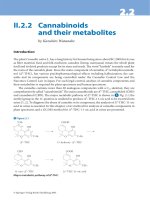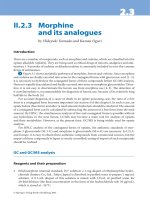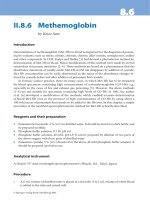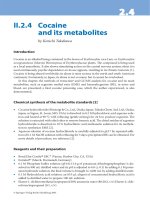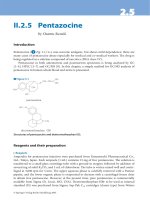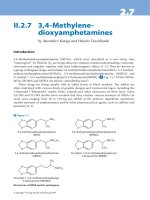Drugs and Poisons in Humans - A Handbook of Practical Analysis (Part 22)
Bạn đang xem bản rút gọn của tài liệu. Xem và tải ngay bản đầy đủ của tài liệu tại đây (391.71 KB, 12 trang )
2.42.4
© Springer-Verlag Berlin Heidelberg 2005
II.2.4 Cocaine
and its metabolites
by Kenichi Takekawa
Introduction
Cocaine is an alkaloid being contained in the leaves of Erythroxylon coca Lam. or Erythroxylon
novogranatense (Morris) Hieronymus of Erythroxylaceae plants. e compound is being used
as a local anaesthetic. It also shows stimulating action on the central nervous system; when it is
used continuously, psychic dependence on its use appears, resulting in its chronic toxicosis [1].
Cocaine is being abused worldwide; its abuse is most serious in the north and south American
continents. Fortunately, in Japan, its abuse is not so many; but it cannot be overlooked.
In this chapter, the methods of extraction
a
and GC/MS analysis for cocaine and its main
metabolites, such as ecgonine methyl ester ( EME) and benzoylecgonine ( BE), in urine and
blood, are presented; a fatal cocaine poisoning case, which the author experienced, is also
demonstrated.
Chemical synthesis of the metabolite standards [2]
• Cocaine hydrochloride (Shionogi & Co., Ltd., Osaka, Japan; Takeda Chem. Ind. Ltd., Osaka,
Japan; or Sigma, St. Louis, MO, USA) is dissolved in 0.2 M hydrochloric acid aqueous solu-
tion and heated at 90 °C with re uxing (gentle mixing) for 24 h to produce ecgonine. e
solution is extracted with ethyl ether to remove benzoic acid. e dried residue of ecgonine
hydrochloride is dissolved in 10 % hydrochloric acid methanolic solution for its methyla-
tion to synthesize EME [2].
• Aqueous solution of cocaine hydrochloride is carefully adjusted to pH 7 by repeated addi-
tion of 0.1 M NaOH solution with re uxing for 3 days; precipitated BE can be obtained. For
more details of procedure, see reference [2].
Reagents and their preparation
• Bond Elut Certify®
LRC
b
(Varian, Harbor City, CA, USA)
• Extrelut®
c
(Merck, Darmstadt, Germany)
• 0.1 M Phosphate bu er solution (pH 6):13.6 g of potassium dihydrogenphosphate is dis-
solved in 900 mL distilled water and its pH is adjusted to 6.0 (± 0.1) by adding 0.1 M potas-
sium hydroxide solution; the nal volume is brought to 1,000 mL by adding distilled water.
• 0.1 M Hydrochloric acid solution: an 833-µL aliquot of concentrated hydrochloric acid is
added to distilled water to prepare 100 mL solution.
• Eluent-1: dichloromethane/isopropanol/28% ammonia water (80:20:2, v/v) Eluent-2: chlo-
roform/isopropanol (9:1, v/v)
208 Cocaine and its metabolites
• Standard stock solutions: 11.2 mg of cocaine hydrochloride (10 mg of the free form) is dis-
solved in dilute hydrochloric acid solution (0.1 mM, pH 4.0) to prepare 100 mL solution;
EME and BE, 10 mg each, are dissolved in 100 mL methanol respectively. ese stock solu-
tions are appropriately diluted just before use to serve for standard solutions.
• As internal standard (IS)
d
, 3 mg of scopolamine hydrobromide (Kanto Chemicals, Tokyo,
Japan and any other manufacturer) is dissolved in 100 mL distilled water to prepare 30 µg/
mL solution.
• Derivatization reagents
e
: penta uoropropionic anhydride ( PFPA, Tokyo Kasei Kogyo Co.,
Ltd., Tokyo, Japan and other manufacturers); tri uoroacetic anhydride ( TFAA, manufac-
turers the same as above); hexa uoroisopropanol ( HFIP, Kanto Chemicals, Tokyo, Japan
and other manufacturers).
Storage of specimens
f
[3–5]
Cocaine is rapidly metabolized
g
by enzymes such as cholinesterase and by chemical reaction
a er its absorption into bodies; these reactions continue postmortem. erefore, the analysis
of cocaine in an unchanged form in biomedical specimens depends on how to stop the
metabolism and decomposition of cocaine in a matrix and how to keep its concentrations at
the point of analysis. For these purposes, the following treatments should be made as soon as
possible a er sampling specimens:
• Addition of cholinesterase inhibitors ( sodium uoride, eserine, organophosphorus com-
pounds and others)
• Adjustment of pH to 5.0 for specimens by adding acidic solutions
• Storage in a refrigerator or in a frozen state.
GC/MS
conditions
h
Gas chromatograph/mass spectrometer: Finnigan Polaris Q ( ermoquest, Austin, TX,USA);
column: Rtx-5MS (30 m × 0.25 mm i. d., lm thickness 0.25 µm, Restek, Bellefonte, PA, USA);
column temperature: 50 °C → 25 °C/min →150 °C(3 min) →10 °C/min → 300 °C; injecor tem-
perature: 250 °C; transfer line temperature: 300 °C; carrier gas: He; its ow rate: 0.9 mL/min;
injection mode: splitless; measurement: scan mode.
Procedures
Since cocaine in biomedical specimens is rapidly hydrolyzed, the specimens
i
should be treated
for its preservation immediately a er sampling, and processed for extraction and derivatiza-
tion procedure. Good recoveries of cocaine and its metabolites can be obtained with a mixed
type extraction column (Bond Elut Certify®) and a diatomite column (Extrelut®). e extrac-
tion with the diatomite column is somewhat inferior in puri cation ability, but gives good re-
coveries with simple procedure and thus is useful in forensic toxicology.
209
a) Procedure I (Bond Elut Certify
®
) [6–8]
i. Extraction from urine and derivatization
i. A 5-mL volume of urine is mixed with 5 mL of 0.1 M phosphate bu er (pH 6) and 100 µL
IS solution.
ii. e column is activated by passing 3 mL methanol and then 3 mL of 0.1 M phosphate
bu er solution (pH 6) through it
j
.
iii. e above urine mixture is poured into the column to let it ow slowly (about 1 mL/
min)
k
.
iv. e column is washed with 5 mL distilled water, 3 mL of 0.1 M hydrochloric acid solution
l
and 9 mL methanol, and aspirated with reduced pressure for more than 5 min to dry the
column
m
.
v. Cocaine and its metabolites are eluted with 3 mL of the Eluent-1.
vi. e eluate is evaporated to dryness under a stream of nitrogen
n
with warming at 50 °C. e
residue is dissolved in a small amount of methanol
o
and transferred to a reaction vial. e
solution is again evaporated to dryness under a stream of nitrogen, mixed with 100 µL
PFPA and 50 µL HFIP, capped airtightly, and heated at 70 °C for 30 min for derivatiza-
tion.
vii. A er the reaction, the solvent is removed under a gentle stream of nitrogen; the residue is
dissolved in 100 µL ethyl acetate to be subjected to GC/MS analysis.
ii. Extraction from blood and derivatization
i. A 1-mL volume of blood (plasma) is mixed with 100 µL IS solution and 5 mL methanol,
vortex-mixed for 1 min and centrifuged to separate a supernatant fraction. Another 3-mL
methanol is added to the sediment in the centrifuge tube, vortex-mixed and centrifuged in
the same way.
ii. e supernatant fractions are combined and concentrated (under a stream of nitrogen or
in a rotary evaporator) to not larger than 1 mL, mixed with 5 mL of 0.1 M phosphate bu er
solution (pH 6) and centrifuged. e supernatant fraction is poured into the Bond Elut
Certify column.
iii. e following procedure is exactly the same as described above for the urine specimen.
b) Procedure II (
Extrelut
®
) [5]
i. A 1-mL volume of blood (plasma) is mixed with 4 mL distilled water; in the case of urine,
5 mL is used without any dilution. e 5 mL specimen is mixed with 100 µL IS solution
and its pH is adjusted to 8–9
p
with 10 % ammonia water.
ii. e above solution is poured into the Extrelut® column and le for 20 min.
iii. Cocaine and its metabolites are eluted from the column with 30 mL of the Eluent-2.
iv. e eluate is evaporated to dryness under reduced pressure with warming at 50 °C. e
residue is dissolved in 100 µL PFPA and 50 µL HFIP, capped airtightly and heated at 70 °C
for 30 min for derivatization. A 1–2 µL aliquot of it is subjected to GC/MS analysis.
Cocaine and its metabolites
210 Cocaine and its metabolites
c) Construction of calibration curves
q
i. To each blank blood (1 mL) and urine (5 mL), are added 100 µL IS solution, cocaine (100–
1,000 ng/mL), EME (100–1,000 ng/mL) and BE (200–1,000 ng/mL).
ii. e specimens are subjected to either Procedure I or Procedure II.
iii. For each calibration curve, peak area ratio of a compound to IS is used for the vertical axis.
Monitor ions used are ; EME-PFP: m/z 82; BE-HFIP: m/z 318; cocaine: m/z 82; scopol-
amine-PFP (IS): m/z 138.
Assessment and some comments on the methods
It is not easy to simultaneously extract cocaine, EME and BE by liquid-liquid extraction due to
the high polarity of BE. However, the three compounds can be simultaneously extracted with
the Bond Elut Certify® and Extrelut® columns with high e ciency. e recovery rates were not
lower than 86 % for the three compounds with the Bond Elut Certify® column [7,8] and not
lower than 81 % with the Extrelut® column [5].
> Figure 4.1 shows a TIC and mass chromatograms (MCs) of cocaine (100 ng), EME
(100 ng), BE (200 ng) and IS, which had been spiked into 1 mL blood before extraction with a
Bond Elut Certify® column and PFP-HFIP derivatization. In the TIC, many big impurity peaks
appeared; the test peaks were small. Each mass spectrum contained some impurity peaks, but
by subtracting background impurity peaks from the test mass spectrum, a clean spectrum can
be obtained, which is almost identical to that of the authentic standard. By mass chromatogra-
phy, quantitative analysis can be achieved without any interference by impurities.
> Figure 4.2
shows mass spectra of the authentic cocaine, EME and BE a er derivatization.
Setting up of cuto values are very common in USA and Europe as a part of QC ( quality
control) and QA ( quality assurance) system; the idea is useful to suppress the discrepancies of
results among testing institutions and to secure the accuracy of each analysis. e cuto values
[9] of BE in urine for cocaine abuse being established in U.S.A. are 300 ng/mL for the primary
judgement by immunoassays, and 150 ng/mL for the secondary judgement by GC/MS. How-
ever, in Japan, such criteria set by o cial institutions are not available for drugs of abuse. Upon
judgements of analytical data, the idea of cuto values should be adopted with reference to the
values established in USA or Europe. When BE in urine is analyzed by GC/MS in the full scan
mode for both mass spectral measurements and quantitation by mass chromatography, the
most suitable cuto value seems to be 300 ng/mL.
Poisoning case
Numerous fatal cocaine poisoning cases were reported in USA, but in Japan the number of
such cases is limited. e author et al. experienced a fatal cocaine poisoning case and measured
concentrations of cocaine and its metabolites in body uids and various organs.
A 41-year-old male was found dead in a hotel room. e clothes on the corpse were not
disordered; no external wounds could not be found. However, the skin around both nostrils
was reddened erosively. In his room, nine small empty polyethylene bags, to which small
amounts of cocaine powder adhered were found; methamphetamine powder, cannabis resin
211
Total ion chromatogram (TIC) and mass chromatograms for the PFP-HFIP derivatives of the
extract of 1 mL blood, to which 100 ng cocaine, 100 ng EME and 200 ng BE had been added.
⊡ Figure 4.1
Poisoning case


